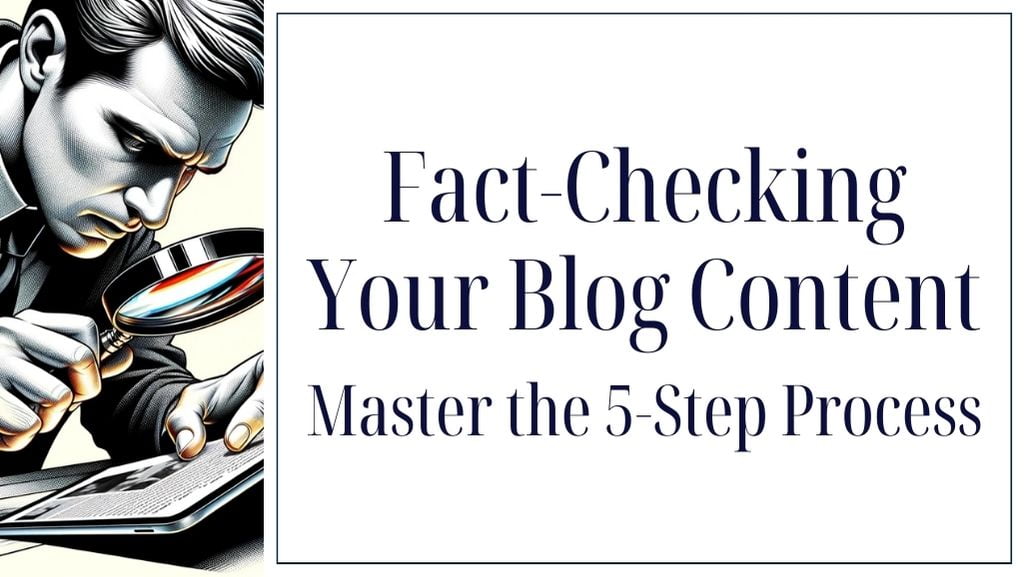Your blog’s power depends on the truth — plain and simple. Fact-checking isn’t just a good habit; it’s the backbone of your online presence.
Stay with me here, and I’ll break down five straightforward steps to make sure your business blogging stands firm and reliable.
You want to build a loyal audience? It starts with posts they can trust, every single time.
Step 1: Building a Knowledge Base through Preliminary Research
As a business blogger, your credibility depends on the accuracy of your content. It’s critical to establish a solid base of trustworthy information through rigorous preliminary research before you move on to the crafting stage.
Identifying Reliable Primary and Secondary Source Materials
Locate cutting-edge authoritative publications, academic journals, verified statistical databases, trade association reports, and government agency resources.
These are not just gold mines of information; they are the bedrock of facts that back up your blog’s arguments.
Quality industry resources are up-to-date, supported by substantial research, and authored by recognized experts in the field.
High-caliber sources often display a history of citations in other scholarly work, demonstrating their impact on the industry.
You’re not just hunting for facts; you’re also seeking legitimacy for your blog.
Check the authors and institutions behind your sources for their credentials and contributions to the field. Look closely at the potential biases they might hold and choose sources that are balanced, reputable, and peer-reviewed.
The sources should present a clear methodology for how data was collected and analyzed. Beware of outdated or irrelevant resources that can skew your blog’s accuracy.
Organizing and Documenting Facts, Data, and Sources
Gather up your facts and line them up ready to be questioned with a single touch of scrutiny.
Develop a methodical system for organizing the information you gather. Use digital tools like custom databases or annotated bibliographies, and embrace spreadsheets for their simplicity in storing and sorting data.
Include essential metadata for each fact: author names, publication dates, page numbers, and direct URLs where applicable.
Your record-keeping should be as meticulous as a librarian’s.
Standardize a notation system that makes your fact-checking traceable and reproducible. Whether it’s a footnote, endnote, or a parenthetical insertion, your documentation should be rock solid.
Remember, you are building a fortress of information that can’t be questioned or doubted.
This step is foundational, not just for your current post but for the credibility and longevity of your entire blog.

Step 2: Rigorously Evaluating and Cross-Checking All Collected Facts
With all the facts at your fingertips, you must now transition to the meticulous process of evaluation and cross-checking. Remember, a single unchecked error can disrupt your entire narrative, shaking the trust you’ve built with your audience.
Identifying The Types of Factual Information Necessitating Verification
You need to be aware that not all facts are created equal.
Math statistics, for example, demand a numerical accuracy that can often be confirmed through datasets and calculators.
Scientific data should always be backed by experiments and peer-reviewed articles.
Historical events require dates and outcomes confirmed by multiple history sources.
Geographic details hinge on maps and government resources.
Profiles should be cross-verified with multiple media reports and direct quotes should always be traced back to the original source.
Each category requires a customized approach to verification.
For scientific data, this might mean consulting the original research.
For historical events, it means checking against established timelines in history books and archives.
Consulting Multiple High-Quality Sources to Confirm Accuracy
Efficiency in locating authoritative sources is crucial.
Use academic databases and industry-specific publications that independently report the same facts.
When cross-referencing, be on alert for any differences in data or quotes.
These inconsistencies are red flags that necessitate a deeper dive into the reliability of each source.
Address differences by probing into the reliability and recency of each publication.
Measurement differences or conflicting accounts can be unraveled by understanding the context in which each source was produced.
Where there’s smoke, there’s often fire; where there’s consensus, there’s likely truth.
Through deliberate and careful analysis, employing these strategies ensures that the foundation of your content is as resilient as the trust you aim to build with it.
Step 3: Authenticating Quotes, Testimonials, and Original Source Media
Blog content is often elevated by the inclusion of powerful quotes, compelling testimonials, and striking media.
But you must be vigilant.
It’s your duty to verify that these elements are legitimately sourced and accurately represented in your blog.
Tracing Quotes and Testimonials Back to a Credible Original Context
Firstly, pin down the origin of the quote or testimonial. Determine the initial publication date and the medium in which it was featured.
Ensure the statement’s phrasing is precise; otherwise, you risk compromising its integrity.
Never underestimate the significance of context – it shapes the entire meaning behind a statement.
Always provide full citation details in your content with appropriate references or links.
Avoid common missteps such as fabricated quotes, misattribution, or slicing sentences to fit your narrative. It’s not only unethical but can irreparably damage your reputation with readers.
Fact-Checking Photos, Videos, and Other Media via Reverse Image Search
To authenticate images and videos, reverse image search engines are indispensable. Tools like Google Images or TinEye allow you to trace media back to original instances.
Scrutinize the search outcomes for matches on authoritative sites – this is crucial in establishing the media’s legitimacy. If something seems amiss, seek out the source to verify its authenticity.
Want to carry out a reverse image search? It’s simple.
First, secure the image – download it directly or capture the URL – and then paste it into the search engine.
Evaluate the search results carefully, considering the credibility of websites that have previously used the image.
If you spot potential issues of theft or manipulation, doing this groundwork is imperative to preserve the trustworthiness of your content.
Step 4: Ensuring Content Cohesion through Logical Consistency Checks
It’s crucial to weave the fabric of your content with threads of logic and consistency. Beyond the painstaking accuracy of facts, your post must clearly articulate a story that guides the reader with ease and purpose.
Evaluating Flow, Tone, Format, and Readability
Review the structure of your post.
Just as you wouldn’t build a house on an unstable foundation, don’t build your argument on a jumbled sequence of ideas.
Confirm that each section logically leads to the next, with clear transitions that don’t disrupt the reader.
Consider your tone. Just as a shifting mood can confuse a conversation, inconsistency in tone can bewilder your readers.
Ensure that your style is consistent and suits your subject and audience, and that the format helps, rather than stops, understanding.
The readability of your content is non-negotiable. It determines whether your message is easily understood or hard to grasp.
Resolving Factual Contradictions and Inconsistencies
Factual contradictions are stumbling blocks that can trip up a reader and undermine your credibility.
To remove these obstructions, inspect your draft for discrepancies. When you find them, it’s not enough to simply cross out the error.
Return to your sources, identify the correct information, and then carefully integrate the truth back into your story. The integration must flow smoothly, preserving the rhythm and integrity of your article.
The attention to detail here is key: every fact should support, not disrupt, the flow and balance of your content.
Step 5: Instituting Review Procedures and Accountability Policies
Once the careful fact-checking is complete, putting in place strong review procedures and accountability policies is critical to keep the honesty of your blog over the long term.
Peer Review Process
Start with independent peer reviews.
Swapping blog posts with trusted colleagues, hiring freelance editors or forming a blog team, and getting feedback from industry experts can greatly improve the quality of your content.
These reviewers should check the accuracy of facts, data, and quotes, review logical coherence, and confirm that your content connects with your target audience before you publish.
They should also make sure the content provides helpful advice and aligns with the blog’s overall goal.
When setting up this system, remember that feedback goes both ways.
You must be as willing to provide detailed and constructive criticism as you are to receive it.
Create a culture where reviewers don’t just identify problems but also suggest solutions, supporting a cooperative environment that improves the thoroughness of your content’s fact-checking.
Post-Publication Review Processes and Correction Policies
Your responsibility doesn’t end at publication.
Stay engaged with your audience through comments, keeping an eye out for any new research or developments that may impact your content’s accuracy.
Should an error get through, respond quickly with corrections.
Put in place a clear correction policy and make it accessible to your readers.
A simple update note or correction disclaimer not only serves to correct the information but also shows your commitment to openness and accuracy.
These markers act as a trust signal to your readers, showing that you value the factual integrity of your blog as much as they do.

Parting Words
Fact-checking is the backbone of a blog that endures.
You’ve seen the game plan: do your homework, confirm what you find, make sure quotes are real, keep your content consistent, and review everything before and after you hit post.
It’s time to roll up your sleeves and get to work. Use these steps and make your blog the go-to place for reliable information.
Your readers are counting on the accuracy of every post, so give them the solid facts they deserve. By being thorough, you become vital.



